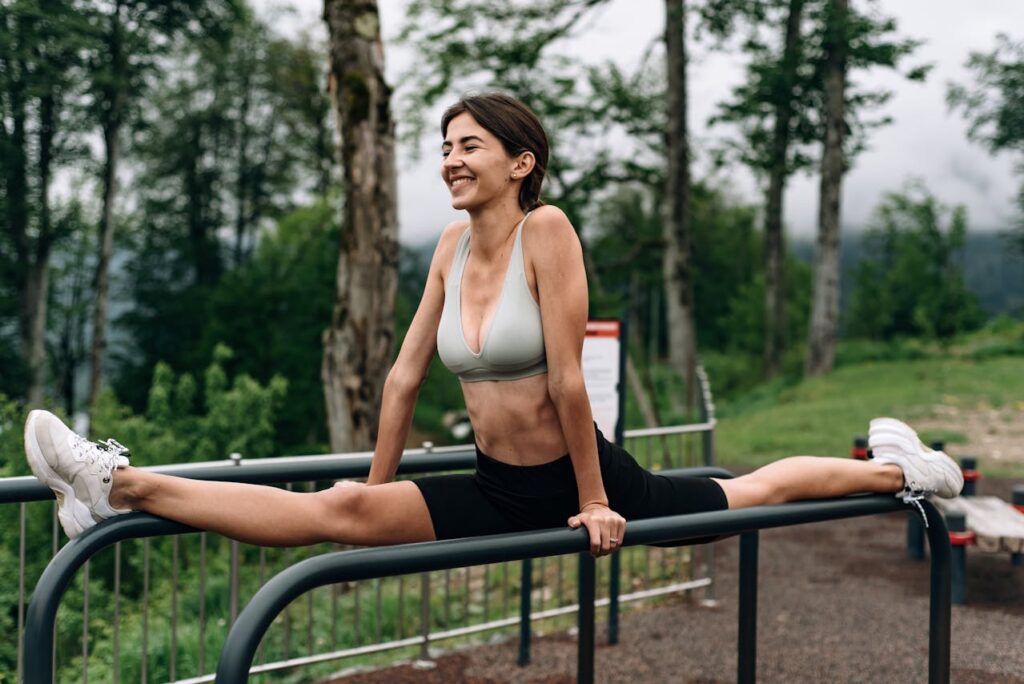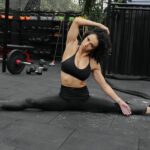Hip internal rotation is one of the most overlooked aspects of hip mobility, yet it plays a crucial role in everything from your daily walk to athletic performance. Whether you’re dealing with tight hips from prolonged sitting, looking to improve your squat depth, or seeking to prevent hip-related injuries, understanding and improving your hip internal rotation can be a game-changer.
In this comprehensive guide, we’ll explore the anatomy behind hip internal rotation, provide you with evidence-based exercises and stretches, and give you the tools to assess and improve your hip mobility safely and effectively.
Understanding Hip Internal Rotation Anatomy
Hip internal rotation occurs when your thigh bone (femur) rotates inward toward the midline of your body. This movement is essential for proper gait mechanics, athletic performance, and maintaining healthy hip joint function.
Key Muscles Involved in Hip Internal Rotation
Several muscle groups work together to create hip internal rotation:
- Tensor Fasciae Latae (TFL): This muscle on the outer hip helps initiate internal rotation
- Gluteus Medius and Minimus: The deeper fibers of these muscles contribute to internal rotation
- Adductor Magnus: The posterior fibers assist with internal rotation
- Pectineus: A smaller hip flexor that also aids in internal rotation
When these muscles are weak or tight, it can lead to compensatory movement patterns that increase injury risk and reduce performance.
Assessing Your Hip Internal Rotation Range of Motion
Before diving into exercises, it’s important to understand what constitutes normal hip internal rotation and how to assess your current mobility.
Normal Range of Motion Standards
- Passive hip internal rotation: 30-40 degrees
- Active hip internal rotation: Approximately 35 degrees
- Functional requirement: Most daily activities require 20-25 degrees
Simple Assessment Test
- Lie on your back with both knees bent to 90 degrees
- Keep your thighs parallel and let one foot fall outward
- Measure the angle between your shin and vertical
- Compare both sides to identify any asymmetries
If you notice significant limitations (less than 20 degrees) or differences between sides (more than 10 degrees), the exercises in this guide can help address these issues.
Best Hip Internal Rotation Exercises
These exercises focus on actively strengthening the muscles responsible for hip internal rotation while improving mobility through movement.
Exercise 1: 90-90 Hip Internal Rotation Lift-Offs
This foundational exercise targets active hip internal rotation strength while improving mobility.
How to perform:
- Sit in a 90-90 position with both knees bent at 90 degrees
- Place your hands behind you for support
- Lift the foot of your front leg off the ground by internally rotating your hip
- Hold for 2-3 seconds, then lower slowly
- Complete 10-15 repetitions before switching sides
Progression: Add ankle weights or hold the lifted position for longer durations.
Exercise 2: Banded Hip Internal Rotation
This exercise uses resistance to strengthen the internal rotators while providing proprioceptive feedback.
How to perform:
- Sit on a chair with a resistance band around your ankles
- Keep your knees hip-width apart
- Slowly rotate one foot inward against the band resistance
- Hold for 2 seconds, then return to starting position
- Complete 12-15 repetitions per side
Modification: Adjust band tension based on your strength level.
Exercise 3: Reverse Clamshells
Unlike traditional clamshells that work external rotation, this variation targets internal rotation.
How to perform:
- Lie on your side with knees bent and stacked
- Keep your feet together and lift your bottom knee toward the ceiling
- Focus on rotating from the hip, not just lifting the leg
- Lower slowly and repeat for 10-12 repetitions
- Switch sides and repeat
Exercise 4: Prone Hip Internal Rotation with Band
This exercise challenges hip internal rotation in a prone position, which is more functional for many activities.
How to perform:
- Lie face down with a resistance band around your ankles
- Bend one knee to 90 degrees
- Rotate your foot outward (which internally rotates your hip)
- Hold for 2 seconds, then return slowly
- Complete 10-15 repetitions per side
Essential Hip Internal Rotation Stretches
While strengthening is important, stretching tight structures that limit internal rotation is equally crucial.
Stretch 1: Modified Pigeon Pose for Internal Rotation
This stretch targets the posterior hip capsule and external rotators that may limit internal rotation.
How to perform:
- Start in a traditional pigeon pose with your front leg bent
- Slowly walk your hands toward the bent leg side
- Feel the stretch in the back of your front hip
- Hold for 30-45 seconds
- Switch sides and repeat
Stretch 2: Supine Hip Internal Rotation Stretch
This gentle stretch can be performed daily to maintain hip internal rotation mobility.
How to perform:
- Lie on your back with one knee bent to your chest
- Gently pull your knee across your body toward the opposite shoulder
- Keep your pelvis stable and avoid rolling
- Hold for 30 seconds
- Repeat 2-3 times per side
Stretch 3: Seated Figure-4 Internal Rotation Stretch
This stretch targets multiple structures that can limit hip internal rotation.
How to perform:
- Sit in a chair with one ankle resting on the opposite knee
- Gently lean forward while pressing down on the raised knee
- You should feel a stretch in the hip and glute of the raised leg
- Hold for 30-45 seconds
- Switch sides and repeat
Programming Your Hip Internal Rotation Routine
Frequency and Sets
- Beginners: 3-4 times per week, 2 sets of each exercise
- Intermediate: 4-5 times per week, 2-3 sets of each exercise
- Advanced: 5-6 times per week, 3 sets with added resistance or complexity
Progression Timeline
- Weeks 1-2: Focus on form and establishing the movement patterns
- Weeks 3-4: Increase repetitions and hold times
- Weeks 5-8: Add resistance or progress to more challenging variations
- Week 8+: Maintain gains with 2-3 sessions per week
Workplace-Friendly Hip Internal Rotation Exercises
For those spending long hours at a desk, these exercises can be performed throughout the workday to maintain hip mobility.
Seated Chair Hip Internal Rotation
- Sit tall in your chair with feet flat on the floor
- Lift one foot slightly and rotate it inward
- Hold for 5 seconds, then relax
- Repeat 10 times per side every hour
Desk-Supported Hip Circles
- Stand behind your chair, holding the back for support
- Lift one leg slightly and make small circles
- Focus on moving through internal and external rotation
- Complete 5 circles in each direction per leg
Sport-Specific Applications
For Runners
Hip internal rotation is crucial for proper gait mechanics. Limited internal rotation can lead to:
- Increased stress on the IT band
- Knee pain and tracking issues
- Reduced running efficiency
For Athletes
Sports requiring cutting, pivoting, and rotational movements depend heavily on hip internal rotation:
- Soccer: Kicking and change of direction
- Basketball: Defensive slides and pivoting
- Golf: Hip rotation during the swing
- Tennis: Rotational power generation
Addressing Bilateral Asymmetries
It’s common to have differences between your left and right hip internal rotation. Here’s how to address them:
Assessment Protocol
- Test both sides using the supine assessment described earlier
- Note any differences greater than 10 degrees
- Focus additional attention on the more limited side
Corrective Strategy
- Spend 50% more time on exercises for the limited side
- Perform unilateral stretches holding the tight side 1.5x longer
- Monitor progress weekly and adjust accordingly
When to Seek Professional Help
While these exercises are generally safe, certain conditions require professional evaluation:
Red Flags
- Sharp, shooting pain during exercises
- Significant swelling or warmth in the hip joint
- Numbness or tingling in the leg
- Pain that worsens with rest
Conditions Requiring Caution
- Femoroacetabular Impingement (FAI): May require modified exercises
- Hip labral tears: Need specific rehabilitation protocols
- Previous hip surgery: Requires clearance from your surgeon
- Pregnancy: Hormonal changes affect joint stability
Troubleshooting Common Form Mistakes
Mistake 1: Using Momentum Instead of Control
Solution: Slow down movements and focus on 2-3 second holds in the end position.
Mistake 2: Compensating with Lumbar Spine Movement
Solution: Keep your core engaged and avoid arching or rounding your back during exercises.
Mistake 3: Forcing Range of Motion
Solution: Work within pain-free ranges and gradually progress over time.
Mistake 4: Neglecting the Opposite Movement
Solution: Balance internal rotation work with external rotation exercises to maintain joint health.
Age-Related Considerations
Young Athletes (Under 18)
- Focus on movement quality over intensity
- Emphasize proper warm-up before activities
- Monitor for growth-related changes in flexibility
Adults (18-65)
- Standard protocols apply
- Pay attention to occupational demands (sitting, standing, lifting)
- Consider hormonal influences on joint mobility
Older Adults (65+)
- Start with gentler progressions
- Allow longer warm-up periods
- Focus on functional movements for daily activities
- Consider balance and fall prevention aspects
Integrating Hip Internal Rotation into Your Overall Mobility Routine
Hip internal rotation doesn’t exist in isolation. Here’s how to integrate it into a comprehensive mobility program:
Daily Routine Structure
- Warm-up (5 minutes): Light movement and dynamic stretches
- Hip internal rotation focus (10-15 minutes): Exercises from this guide
- Complementary movements (10 minutes): Hip flexor stretches, external rotation
- Cool-down (5 minutes): Gentle stretches and relaxation
Weekly Programming
- Monday/Thursday: Focus on strengthening exercises
- Tuesday/Friday: Emphasize stretching and mobility
- Wednesday/Saturday: Combined approach with sport-specific movements
- Sunday: Active recovery with gentle movement
Frequently Asked Questions
How long does it take to see improvements in hip internal rotation?
Most people notice improvements in mobility within 2-3 weeks of consistent practice. Strength gains typically take 4-6 weeks to become apparent. However, individual results vary based on starting mobility, consistency, and underlying factors.
Can I do these exercises if I have hip pain?
Mild discomfort during stretching is normal, but sharp or severe pain is not. If you experience pain during these exercises, stop immediately and consult a healthcare professional. Many hip conditions can be helped with proper exercise, but some require specific modifications.
Should I feel a stretch during the strengthening exercises?
The strengthening exercises may produce a mild stretching sensation, especially if you have limited mobility. However, the primary focus should be on muscle activation and control rather than aggressive stretching.
How do I know if I’m making progress?
Track your progress by:
- Measuring your range of motion weekly using the assessment test
- Noting improvements in exercise difficulty or repetitions
- Observing better performance in daily activities or sports
- Reduced stiffness or discomfort during movement
Is it normal to have different mobility on each side?
Some asymmetry is normal, but significant differences (more than 10-15 degrees) may indicate imbalances that should be addressed. Focus additional attention on the more limited side while maintaining the mobility of the better side.
Conclusion and Next Steps
Improving your hip internal rotation is an investment in your long-term mobility, performance, and injury prevention. The exercises and stretches outlined in this guide provide a comprehensive approach to addressing this often-neglected aspect of hip health.
Remember that consistency is key – small, regular efforts will yield better results than sporadic intensive sessions. Start with the basic exercises and progressions, listen to your body, and gradually advance as your mobility and strength improve.
Your Action Plan:
- Assess your current hip internal rotation using the test provided
- Choose 2-3 exercises and 1-2 stretches to start with
- Commit to practicing 3-4 times per week for the next month
- Track your progress weekly
- Gradually progress to more challenging variations as you improve
If you experience any concerning symptoms or have underlying hip conditions, don’t hesitate to consult with a physical therapist or healthcare provider who can provide personalized guidance for your specific situation.
Take the first step today – your hips will thank you for the attention, and you’ll likely notice improvements in how you move, feel, and perform in all areas of life.



